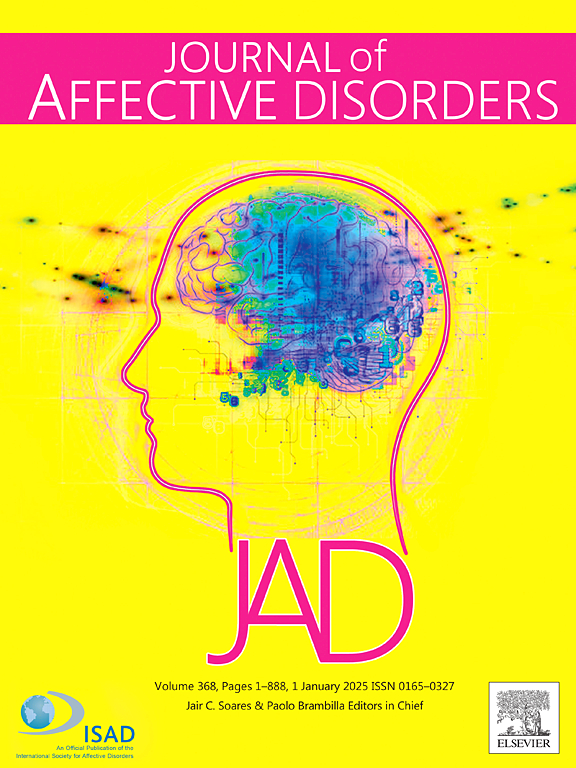2017年至2022年大型医疗保健系统中双相情感障碍锂和抗抑郁药处方的趋势和决定因素
IF 4.9
2区 医学
Q1 CLINICAL NEUROLOGY
引用次数: 0
摘要
背景:先前的研究提出了对双相情感障碍(BP)治疗中锂的使用减少和抗抑郁药使用增加的担忧。我们描述了最近的趋势,精神药物处方的BP和检查人口,社会经济和临床因素相关的处方。方法:我们分析了2017年至2022年大型学术卫生系统中12824例BP患者的电子健康记录数据。我们计算了BP药物的年处方率,然后使用逻辑回归来检查与处方相关的因素。结果:我们发现锂盐处方略有增加,抗抑郁药略有减少。27% %的患者服用了锂,52% %的患者服用了抗抑郁药,近一半的患者没有同时服用情绪稳定剂。病人是黑人(优势比[或] = 0.70 95 %可信区间[CI] = 0.65 - -0.76),有公共保险(或 = 0.87,95 CI % = 0.81 - -0.94),住在更高领域社会剥夺(或 = 0.84,95 CI % = 0.76 - -0.93),或被认为在初级保健(或 = 0.21,95 CI % = 0.17 - -0.24)不太可能规定的锂。生活在贫困地区的患者(OR = 1.42,95 % CI = 1.20-1.68)年龄较大(60+; = 2.64,95 % CI = 1.96 - -3.58),和被认为在初级保健(或 = 7.46,95 CI % = 6.43 - -8.66)更有可能规定没有伴随的心境稳定剂抗抑郁药。结论:锂盐虽然是治疗BP的一线药物,但仍未得到充分利用,特别是在某些亚组中。抗抑郁药被广泛用于治疗血压,尽管大多数临床指南都很谨慎,但通常不使用情绪稳定剂。这些发现强调了继续努力促进使用最佳循证治疗BP和减少其使用差异的必要性。本文章由计算机程序翻译,如有差异,请以英文原文为准。
Trends and determinants of prescription of lithium and antidepressants for bipolar disorder in a large health care system between 2017 and 2022
Background
Previous studies raised concerns about declining use of lithium and increased use of antidepressants in treatment of bipolar disorder (BP). We describe recent trends in prescription of psychotropic medications for BP and examine demographic, socioeconomic and clinical factors associated with their prescription.
Methods
We analyzed data from the electronic health records on 12,824 patients with BP in a large academic health system between 2017 and 2022. We calculated annual prescription rates for BP medications, and then used logistic regression to examine factors associated with their prescription.
Results
We found a modest increase in lithium prescription and a slight decrease for antidepressants. Lithium was prescribed to 27 % of patients, while antidepressants were prescribed to 52 % of patients, nearly half without a concomitant mood stabilizer. Patients who were Black (odds ratio [OR] = 0.70 95 % confidence interval [CI] = 0.65–0.76), had public insurance (OR = 0.87, 95 % CI = 0.81–0.94), lived in areas of higher social deprivation (OR = 0.84, 95 % CI = 0.76–0.93), or were seen in primary care (OR = 0.21, 95 % CI = 0.17–0.24) were less likely to be prescribed lithium. Patients who lived in areas of greater deprivation (OR = 1.42, 95 % CI = 1.20–1.68), were older (60+; OR = 2.64, 95 % CI = 1.96–3.58), and were seen in primary care (OR = 7.46, 95 % CI = 6.43–8.66) were more likely to be prescribed antidepressants without a concomitant mood stabilizer.
Conclusions
Lithium remains underutilized even though it is a first-line treatment for BP, especially among certain sub-groups. Antidepressants are widely used to treat BP, often without mood stabilizers despite caution by most clinical guidelines. These findings underscore the need for continued efforts to promote use of best evidence-treatments for BP and reduce disparities in their use.
求助全文
通过发布文献求助,成功后即可免费获取论文全文。
去求助
来源期刊

Journal of affective disorders
医学-精神病学
CiteScore
10.90
自引率
6.10%
发文量
1319
审稿时长
9.3 weeks
期刊介绍:
The Journal of Affective Disorders publishes papers concerned with affective disorders in the widest sense: depression, mania, mood spectrum, emotions and personality, anxiety and stress. It is interdisciplinary and aims to bring together different approaches for a diverse readership. Top quality papers will be accepted dealing with any aspect of affective disorders, including neuroimaging, cognitive neurosciences, genetics, molecular biology, experimental and clinical neurosciences, pharmacology, neuroimmunoendocrinology, intervention and treatment trials.
 求助内容:
求助内容: 应助结果提醒方式:
应助结果提醒方式:


